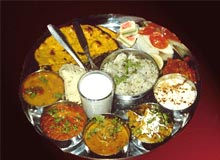Gurajati heritage

Gujarat diversity map. @Gujarat Spider, 2015
To understand who Saujani is, it helps to understand where she comes from. While she was born in Illinois, her heritage is Indian, specifically Gujarati.
Gujarat is known as the “Heart of India.” It is multicultural, and hold strong values on arts, culture, and traditions that have been passed down from generations before. Gujarat is famous on the political front because it is the birthplace of Mahatma Ghandi, who is loved and revered for his strong stance against violence.
Gujarat has a vegetarian diet of green vegetables, cerals, fruits, milk, ghee, buttermilk, rice, farsan, and dal (lentils). They also fill their plates with chutney, pickles, padpad, and a variety of other area cuisine. (Gujarati food, n.d.)

A typical Gujarati meal. @Cultural India, 2015
The religious beliefs of the people in Gujarat are varied, while Saujani’s family is Hindu, Gujarat also has people of Jainism and Buddism, as well as other smaller sects. The people of Gujarat are “God fearing, friendly, and good natured.” (All About, 2014)
Traditionally, families who migrate to America and other countries try to preserve their culture as much as possible. They tend to live in nuclear families, and have extended family visit for long periods of time. Their diet is still rooted in Indian cuisine, as is the tradition of sitting together at dinner and discussing the events of the day. Women are the predominant preparers of food, with their daughters expected to help, while, for most part, sons are not. Preparation is made easier with the use of kitchen appliances and canned foods, but for the most part the tradition of freshly prepared foods is held to. (All about, 2014)
Growing up in America
In the 1970’s, the culture of America was fighting for redefinition. Women and other minorities were fighting for equality. The Vietnam War was forefront on the minds of many, and many joined the protests against the U.S. involvement. President Richard Nixon stepped down after the Watergate scandal. (The 1970’s)
Advances in home use technology in U.S. households in the 70’s were things like refrigerators, freezers, washing machines and dryers, electric ranges, 8 track tape players, crock pots, blenders, electric fondue pots, toasters, popcorn poppers, food processors, microwave ovens, dishwashers, radio alarm clocks, and coffee makers. Televisions made the change from black and white to color, allowing a more realistic view of what was being beamed into homes. The music industry benefitted from the transition from the 8 track tape to the cassette, and the world was beginning to get bigger with the introduction of the home computer. (1970’s, 2014) From the toy technology aspect, the Rubix Cube made the scene in 1977, providing countless hours of entertainment and frustration for millions of adults and children.(Bellis, M. 2015)

Rubix Cube @William Warby, 2012
The 80’s brought a wave of personal technology, with computers becoming more common in the homes and cell phones beginning to be available. Satellite dishes and VHS players brought movies and music, like MTV, into homes more than ever before. Portable audio players, commonly called “boom boxes” were the top of the Christmas list for most teenagers, and the Cabbage Patch doll was introduced. Nintendo replaced the Atari as the most wanted game console, and disposable cameras made the scene, making it easier to photograph life events.

